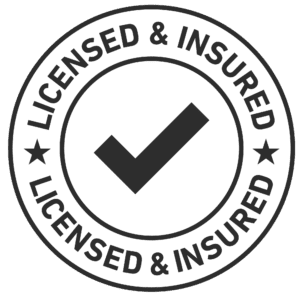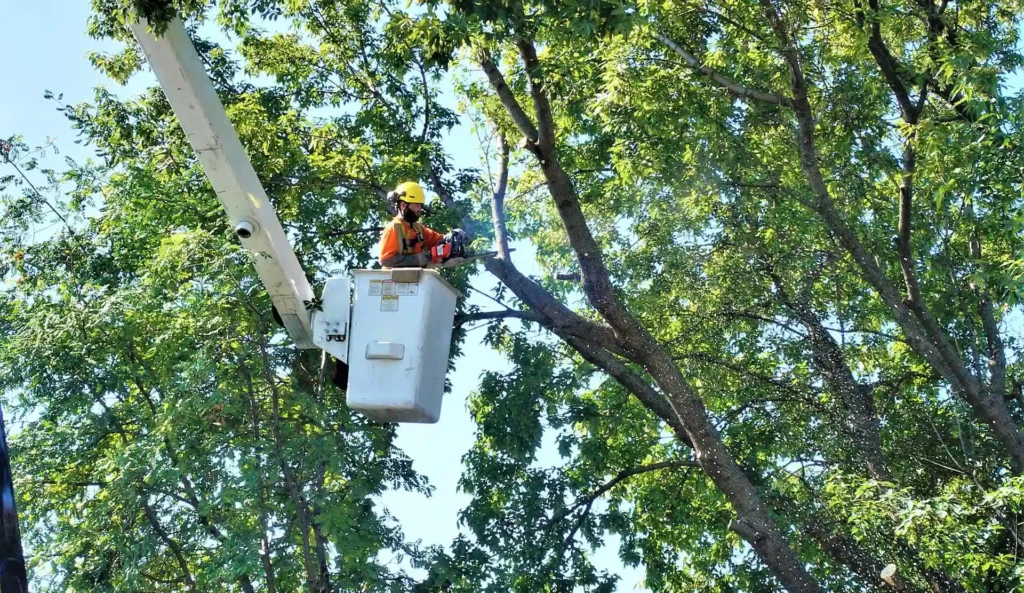As a homeowner in Canada, you may have beautiful trees on your property. However, when tree branches hang over your roof, they can pose several potential problems. From causing damage to your roof to creating a breeding ground for pests, it’s important to address this issue proactively.
In this blog, we’ll discuss the steps you should take if tree branches are overhanging your roof. We’ll also cover how to deal with the safety concerns, potential damage, and maintenance required to ensure your roof and trees remain in top condition throughout the year.
Why Are Overhanging Tree Branches a Concern?
Before anything else, it’s important to understand why overhanging branches can be a problem:
- Roof Damage: As branches rub against your roof or come into contact with shingles, they can cause wear and tear, potentially leading to leaks or even holes.
- Falling Debris: During storms or heavy winds, branches can break off and land on your roof, causing physical damage or clogging your gutters.
- Pest Attraction: Overhanging branches can act as a bridge for pests like squirrels, rodents, and insects, which can then find their way into your attic or other parts of your home.
- Moss and Mold Growth: Overhanging branches can also obstruct sunlight, creating a damp environment that encourages the growth of moss and mold on your roof.
How to Deal With Overhanging Branches
1. Assess the Situation: Identify the Risks
The first step in dealing with overhanging branches is to assess the situation and determine the potential risks involved.
- Branch Size and Health: Are the branches large and heavy, or are they smaller and less likely to cause significant damage? Are they healthy, or do they look weak or diseased?
- Proximity to Your Roof: How close are the branches to your roof, and are they touching it? Are they hanging precariously or moving in the wind?
- Seasonal Considerations: In Canada, the weight of snow and ice during the winter months can be a serious concern. Branches that seem safe in the summer might be at risk of breaking during a heavy snowfall.
2. Trim the Branches: DIY Vs. Professional Help
Once you’ve assessed the situation, you may want to trim the branches to prevent any future problems. Depending on the size and accessibility of the tree, you can either handle the job yourself or hire a professional.
DIY Tree Trimming
If you decide to trim the branches yourself, keep these tips in mind:
- Use the Right Tools: A pruning saw or tree trimmer will be necessary for larger branches. For smaller branches, a good pair of pruning shears should suffice.
- Safety First: Always use a ladder that is stable, and avoid working on a ladder during windy or rainy conditions. Wear safety gear, such as gloves and eye protection.
- Cut Back the Branches: Ensure that you trim the branches far enough from the roof to avoid any contact. Cutting the branches at a 45-degree angle will help prevent water from collecting on the cut surface.
- Dispose of the Debris: After cutting the branches, ensure you clean up the debris properly. Large branches may need to be cut into smaller sections for easy disposal.
Professional Tree Services
If the branches are too high or the tree is too large for you to manage safely, it’s best to call in a professional tree service. They have the expertise and equipment to trim branches without causing harm to the tree or your property.
Hiring a certified arborist ensures the work is done correctly and safely, especially if your tree is large or diseased. Additionally, professionals can inspect the health of the tree and offer advice on whether removal is necessary.
3. Prune Your Trees Regularly: Prevent Future Issues
Preventing future problems involves regular tree maintenance. In Canada, trees should be pruned at least once a year, particularly before the winter season, when heavy snow and ice can weigh down branches.
- Best Time to Prune: The best time to prune your trees is during the late winter or early spring, before the tree starts producing new growth. Pruning in this dormant season minimizes stress on the tree.
- Tree Health: Pruning also helps maintain the health of the tree by removing dead or diseased wood, promoting better airflow, and encouraging stronger growth.
4. Inspect Your Roof: Check for Damage
Once you’ve dealt with the tree branches, it’s a good idea to inspect your roof for any potential damage caused by overhanging branches.
- Look for Leaks: Check your attic and ceilings for signs of water damage, which could indicate a leak from a broken or damaged shingle.
- Inspect Shingles and Gutters: Overhanging branches can scrape against your shingles, loosening them and potentially allowing water to infiltrate your home. Also, check your gutters for debris that could clog them and lead to water damage.
- Moss or Mold Growth: If branches are obstructing sunlight and causing moss or mold to grow on your roof, consider using a roof cleaner or contacting a professional for cleaning.
5. Remove the Tree if Necessary
In some cases, it may be necessary to remove the tree entirely. If the tree is dead or diseased, or if the branches are consistently causing damage to your roof, tree removal may be the best option.
- Tree Removal Permits: In some Canadian municipalities, including Toronto, you may need a permit to remove a tree, especially if it’s on public land or protected. Make sure to check your local regulations before proceeding or better yet, hire professionals for tree removal in Toronto or your city of residence.
- Tree Stump Removal: Once the tree is removed, you may want to have the stump taken out as well. Stumps can attract pests like termites, and they can be an eyesore in your yard.
6. Consider Tree Cabling or Bracing
If you have a large or valuable tree near your home, but you’re concerned about the safety of the branches, consider installing tree cabling or bracing. This method involves installing steel cables or rods to support weak branches and prevent them from falling.
This is typically a service performed by professional arborists and is an option for homeowners who want to preserve their trees while ensuring safety.
Protect Your Roof and Trees
Having tree branches overhanging your roof in Canada is a common problem, but it’s one that can be managed effectively with the right approach. Regular maintenance, careful pruning, and timely inspections will help ensure your trees remain healthy and your roof stays protected.
Whether you decide to tackle the job yourself or hire a professional, taking proactive steps to deal with overhanging branches will protect your home from potential damage, while maintaining the beauty of your trees.
Contact The Real Tree Masters For Expert Services
If you’re in need of tree maintenance or removal services, trust the experts at The Real Tree Masters. Our team of skilled Toronto arborists has the knowledge and experience to handle any tree-related issue with care and efficiency.
We offer a range of services including tree trimming, pruning, tree removal in Toronto, and stump grinding. Contact us today for a free consultation and let us help you keep your trees and property safe and beautiful. Don’t wait until it’s too late – take action now to protect your home from potential damage caused by overhanging branches. Trust The Real Tree Masters for all your tree care needs.




